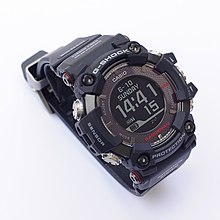G-Shock
The G-Shock is a line of watches manufactured by the Japanese electronics company Casio, designed to resist mechanical stress, shock and vibration.
The G-Shock was conceptualized in 1981 by Casio engineer Kikuo Ibe when he bumped into a pedestrian, and the mechanical watch given to him by his father popped off of his wrist and shattered on the ground.
[3][4][5][6] The shock-resistant design on the original G-Shock has ten layers protecting the quartz timekeeping module,[4] including a urethane rubber bumper, the stainless steel case, the hardened mineral glass watch crystal, the stainless steel screwed down caseback, and the "floating module" where the quartz mechanism floats free in a urethane foam cradle, with the outer buttons and LCD module attached with oblong button shafts.
[7] Initial sales of the G-Shock line were slow in Japan as people preferred dress watches.
A TV news channel then set out to conduct live tests on the DW-5200C to check whether it was as tough and durable as advertised.
The watch survived the impact of the hockey stick, and the G-Shock gained popularity among the general public.
This move would transition into most of the models in the subsequent years, with the original G-Shock square design also adopting the same construction.
Every uneven reception of light by the phototransistor due to impact to the watch enables the stepper motors in the movement to correct the alignment of the hands requiring no manual adjustment.
The hour, minute and second hands feature separate motors in order to allow for quick adjustment of the watch.
[8] The line of watches now includes atomic clock, GPS and Bluetooth time synchronisation and tough solar technology.
Special models are released upon the anniversary celebration of the G-Shock brand and are sold through selected retail channels.
Casio also produces collaboration models, often with popular fashion brands and artists, like A Bathing Ape (Bape), Stüssy,[33] Xlarge, Eric Haze, KIKS TYO, Nano Universe, Levi's, Lifted Research Group, as well as Coca-Cola, Pulp68 Skateshop, Lucky Strike and Marlboro.
G-Shock watches are popular with mountaineers, firefighters, paramedics, people working in the offshore, police officers, astronauts, film directors (Tony Scott was often pictured wearing a GW-3000B, as are Ron Howard and Francis Ford Coppola) and soldiers.
Ex-Special Forces-British SAS soldier Andy McNab mentions in several of his novels how his character Nick Stone relies on a G-Shock watch.
According to Mark Bowden's book Blackhawk Down, the DELTA Operators wore G-Shock watches during the combat events of 3 and 4 October 1993.
[35] The DW-5600UE and the DW-6900UE introduced in November 2023 had the updated 3525 and 3529 modules featuring a backlight consisting of a white LED illuminating the entire screen of the watch for an enhanced seven year battery life replacing the previous modules which had employed the electroluminescent backlight and had only a stated two year battery life.
[36] In 2009, Casio introduced the GW-M5610, a solar powered variant of the DW-5600 incorporating Multi-Band 6 time reception technology and a design homage to the original DW-5000C which was an update to the earlier GW-M5600 model.
[37] The GW-M5610 would spawn many variants, the most notable being the GW-5000 which was a steel cased screw-back variant like the original G-Shock but featured diamond like coating (dlc) on the case and caseback and the GW-S5600 which featured Casio's first application of carbon fibre in a watch strap along with the use of titanium in the caseback, screws and buttons, making it the lightest G-Shock model available.
The watch featured premium finishes throughout its construction without compromising the basic shock resistance of a G-Shock.
In 2019, Casio introduced the production version of the Dream Project which featured an upgraded module now incorporating Bluetooth time reception capabilities in addition to the radiowave time reception and began taking reservations at select G-Shock boutiques in Japan.
Thirty-five units of the Dream Project square would be produced, with each having a retail price of 7.7 million ¥ (69,500 US$ at 2019 exchange rates) excluding taxes making it the most expensive G-Shock watch at the time.
It was also the first G-Shock to feature horizontal calibration which allowed the compass to be operated while the watch is being worn by the user on the wrist.
Due to the octagonal bezel shape bearing a strong resemblance to the Audemars Piguet Royal Oak, the watch was nick-named "CasiOak" by fans.
The watch also features a unique see through module having a main metal face plate, silicone cog wheels and 55 ruby bearings showing the internal working of the components.
[57][58][59] The Multi-Band 6 is a radio control technology first introduced on the GW9200 Riseman in 2008[60] and is a successor to the Multi-Band 5 (which supported synchronisation with five atomic time transmitters around the world) and Wave Ceptor (which supported synchronisation with atomic time transmitters present in the United States and Japan only) technologies.
The following is a list of the six atomic time transmitters: Watches can tune in to two locations: The 40 kHz signal from JJY at Mount Otakadoya, near Fukushima (Ohtakadoyayama).
[61] The Master of G series is the speciality line of G-shocks which were used to introduce new features that would eventually make their way to the standard production models.












